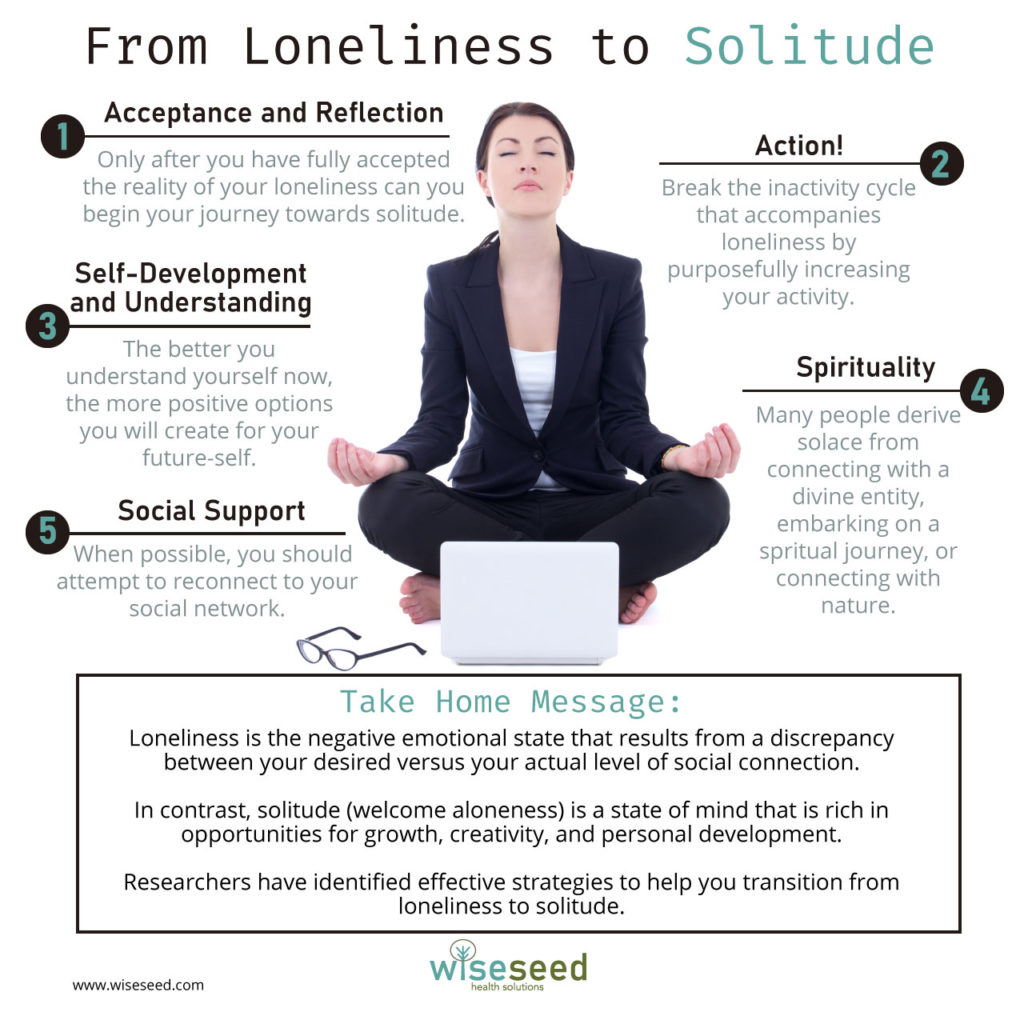Loneliness Part 2: From Loneliness to Solitude

“The more powerful and original a mind, the more it will incline towards the religion of solitude.”
― Aldous Huxley
Loneliness, a brief recap.
In Part One of our series on loneliness, I outlined what loneliness is, why you experience loneliness, and how loneliness impacts your health. In case you missed it:
- You experience loneliness when your actual social life falls short of your desired social life.
- Loneliness evolved to perform two functions: (i) to alert you when your social connections have become damaged, and (ii) to provide you with a powerful emotional drive to rebuild those social connections.
- Unfortunately, our modern social networks, although larger than ever, make it hard to develop and maintain the close social connections that you need to flourish.
- In addition, being lonely can change your mood and behaviour, which makes it even more difficult to connect with other people.
- We all know that loneliness is awful, however research has revealed that loneliness is also bad for your health.
In Praise of Solitude.
Some may argue that lonely people should simply reconnect with their family and make more friends. Problem solved.
If only life was so simple.
The fact is, people aren’t lonely by choice. There exist many barriers to making meaningful connections.
For one, modern social networks favor superficial connections over the deep and long-lasting bonds that you need to flourish. Second, loneliness can alter your behavior, such that it becomes more difficult for you to make friends. Finally, not everyone is good at meeting people and making connections. For these and other reasons, lonely people often find it difficult to make new social connections, which is why they are lonely.
This brings me to the main point of this article. Being lonely and being alone are not the same thing! Solitude is welcomed aloneness. I argue that solitude is the surest path out of loneliness because it doesn’t depend on connecting with other people.
Why do I believe solitude is a viable solution to loneliness?
Because in contrast to loneliness, solitude is a state of mind that is rich in opportunities for growth, creativity, and personal development (1). For example, solitude allows for reflection and greater self-understanding, where you can learn to enjoy your own company in the absence of social pressures.
Moreover, solitude is necessary for engaging in practices such as meditation, deep thinking, creativity, and deep practice. These profoundly rewarding activities are only possible when you have the luxury of being alone.
Six Proven Strategies to Combat Loneliness.
How does one transition from loneliness to solitude?
On this front, we owe a large debt of gratitude to the wonderful research of Dr Ami Rokach.
Dr. Rokach has been studying loneliness and how to deal with it for many years (2). He has surveyed hundreds of people about their most effective strategies for dealing with loneliness and has identified the six most effective strategies that people have used to deal with loneliness in the real world (3, 4).
1. Acceptance and Reflection
Acceptance and reflection require that you face up to your situation and honestly accept the reality of your loneliness (4). Now, I’m not saying that this is going to be a fun process. Far from it! However, only after you have fully accepted the reality of your loneliness can you begin your journey towards solitude and, perhaps, social integration (4).
A critical part of acceptance and reflection is an honest appraisal of your strength, resources, and ability to survive (4). Remember that your ancestors fought off predators and survived famine, plague, and war. Their survival genes are now part of you! As a result, you are far tougher and more resourceful than you think.
With this fact in mind, take some time to make a list of your strengths and resources. These are some of the key assets that will help you thrive in solitude. Remember that although you may currently be lonely, you are far from helpless.
2. Action!
Loneliness often leads to depression and inactivity (4). Rather than immersing yourself in pain, why not deliberately and purposefully engage in life by increasing your activity? This could be taking on more responsibility at work, enrolling in online education, increasing how much you exercise, or just getting out into nature. Perhaps you have a hobby that you’ve been neglecting?
Don’t be afraid to include social activities, for example learning how to dance or joining cooking or art class. The list is endless.
The point is to break the inactivity cycle that accompanies loneliness (4). Where the body leads, the mind follows.
3. Self-Development and Understanding
Within the loneliness literature, self-development and understanding are assumed to occur within focus groups or during one-on-one therapy (4). These are both great options.
However, many of us have neither the opportunity nor the inclination to engage in face-to-face therapy. Fortunately, this doesn’t mean that you are shut off from self-development and understanding. In fact, there are many paths open to you. These include books, free or paid courses, online lectures, blogs, and podcasts. Take advantage of them all.
The better you understand yourself, the more positive, engaging, and meaningful options you will create for your future self.
4. Spirituality/Philosophy
Many lonely people derive solace from connecting with a divine entity, God, or Supreme Being (4). In addition, the ritual that accompanies religious ceremonies can help people cope with loneliness by providing a conduit to the past and future (4).
However, spirituality is not the sole domain of religion. Many people who are not part of a formal religion are nevertheless deeply spiritual. For example, those who engage in a spiritual quest are (i) better at accepting the reality of their situation, (ii) experience profound personal growth, (iii) develop an increased ability to find meaning, and (iii) develop more creative problem-solving strategies (4).
Finally, there’s hope even for atheists! Many established schools of philosophy (such as Stoicism), offer students an intellectually rigorous tradition that provides purpose, meaning, and a coherent worldview. These philosophical schools are a well-trodden path for those who seek a deeper connection to nature and reality but don’t believe in the supernatural.
5. Social Support Network
The focus of this article is transitioning from loneliness to solitude. However, like it or not, we all need social connections to survive and flourish (4). Therefore, when possible, you should attempt to reconnect or mend your social network (4).
Because we’ve discussed at length the benefits of maintaining close friendships, I won’t go into detail. Just keep in mind that at some point you are going to need to reconnect to your community if you want to truly flourish.
6. Detachment and Denial
Sometimes the life event that triggers loneliness can simply be too painful to bear.
Examples include a sudden and horrific break-up, getting fired, or losing a close friend or relative. In these cases, it may be necessary to detach oneself from the situation or even deny the problem outright (4). Often, this process involves alcohol or drugs, but it can also include behaviors such as binge-eating, gambling, or engaging in casual sex.
These forms of escapism can help you process and understand a terrible situation while you are experiencing significant pain (4). While this approach may work in the short term, it’s a terrible long-term solution (hence it’s not included in the infographic!) (4).
If you do find yourself in this situation, then you have a great opportunity to practice self-forgiveness. Obviously, you are not the first person in history to go on a bender. Nevertheless, it’s probably a good idea to move on to Acceptance and Reflection, followed by (positive) Action, as soon as you can bear it.
Take Home Message
Loneliness, while a universal human experience, is profoundly negative. In contrast, solitude (welcomed aloneness) can be an extremely positive and productive state of being. Here, I’ve argued that transitioning to solitude is both an effective and accessible strategy for those who are struggling with loneliness.
However, for many people, escaping the vicious cycle of loneliness is not an easy task. Fortunately, researchers have identified effective strategies that can help you transition from loneliness to solitude. Why not give them a try?
Please click on the link below for your free PDF.

References and Further Reading
1. C. R. Long, J. R. Averill, Solitude: An Exploration of Benefits of Being Alone. Journal for the Theory of Social Behaviour 33, 21-44 (2003).
2. A. Rokach, Antecedents of loneliness: a factorial analysis. J Psychol 123, 369-384 (1989).
3. A. Rokach, The subjectivity of loneliness and coping with it. Psychol Rep 79, 475-481 (1996).
4. A. Rokach, Effective coping with loneliness: a review. Open Journal of Depression 7, 61-72 (2018).
Acknowledgements
Images by Di_Studio and yuran-78
Disclaimer
The material displayed on this website is provided without any guarantees, conditions or warranties as to its accuracy.
Information written and expressed on this website is for education purposes and interest only. It is not intended to replace advice from your medical or healthcare professional.
You are encouraged to make your own health care choices based on your own research and in conjunction with your qualified practitioner.
The information provided on this website is not intended to provide a diagnosis, treatment or cure for any diseases. You should seek medical attention before undertaking any diet, exercise, other health program or other procedure described on this website.
To the fullest extent permitted by law we hereby expressly exclude all warranties and other terms which might otherwise be implied by statute, common law or the law of equity and must not be liable for any damages whatsoever, including but without limitation to any direct, indirect, special, consequential, punitive or incidental damages, or damages for loss of use, profits, data or other intangibles, damage to goodwill or reputation, injury or death, or the cost of procurement of substitute goods and services, arising out of or related to the use, inability to use, performance or failures of this website or any linked sites and any materials or information posted on those sites, irrespective of whether such damages were foreseeable or arise in contract, tort, equity, restitution, by statute, at common law or otherwise.

Ten Minutes is All You Need
Research has shown that ten minutes of moderate-to-vigorous exercise performed each day is enough to significantly reduce your risk of early death.

Overcoming Adversity and Rapid Change
The SPAR methodology provides a simple framework that helps you overcome adversity, adapt to rapid change and achieve your life goals.




